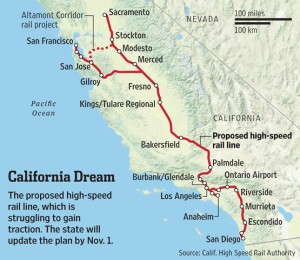
The UN climate conference in Madrid last month may have ended poorly, but conference attendees had a big success story right in front of them. Spain’s success achieving efficient – and enjoyable – land use and transportation outcomes is a model other countries and states should emulate to address climate change.
Spanish cities and towns feature many remarkable urban spaces, not unlike those found in other European countries. These areas tend to prioritize compact apartments located within walking distance of abundant transit, shops, bike lanes and jobs, with many containing pre-automobile-era narrow cobblestone streets built for people and not vehicles. Cities are often built around plazas, typically along with town halls and churches. They also protect against sprawl by prioritizing open space and agricultural land, particularly in the central and southern part of the country. Meanwhile, a high speed rail network connects most of the country’s major urban areas.
The result? While many factors probably come into play, US News in 2019 ranked Spain tops among all countries in terms of the overall happiness of its citizens. The country also ranked 18th in overall quality of life and among the top in food and culture.
You can see this effect on the ground. Spanish cities and towns are among the most walkable and enjoyable cities I’ve experienced. Particularly in the capital city of Madrid, where the UN conference was held, residents can access most destinations by transit or on foot, and the central city is closed to vehicles not registered to central city residents, while any other entering vehicle must meet low- or zero-emission standards. As a result, the Madrid city center is a quiet and clean pedestrian playground. And this same dynamic is present in cities and towns throughout the country, based on my travels there. It’s likely a major reason for the country’s success in terms of emotional well being.

This urban walkability has positive environmental effects, too, particularly on greenhouse gases. According to World Bank figures, Spain’s per capita carbon emissions is 5 metric tons, ranking it approximately 60th on the list of 192 countries, despite having a GDP per capita that ranks roughly 30th. These emission figures stand in stark contrast to the 16.5 metric tons of emissions for the average United States resident, more than 3 times as much as the average Spaniard. And even similarly developed and urban countries like Japan and Germany have almost twice the emissions per capita of the Spanish, with 9.5 per Japanese resident and 8.9 per the average German.
To be sure, some of this climate progress is due to their increasingly clean electricity grid, which has seen a significant deployment of renewables over the past decade. But smaller homes and walkability that decreases driving miles helps, too. For example, overall driving miles (or kilometers, in this case) in the country is relatively low for a developed nation, at approximately 400 billion per year. With 47 million residents in Spain, that equals roughly 8,500 km per person, or 5,287 miles per year (14.5 miles per day per person). By contrast, according to the Eno Center, the average Californian drives 50% more miles than the average Spaniard, at 8,728 miles per year, or 24 miles per day (rural states do even worse, with Wyoming at a whopping 16,900 miles per year, or 46 miles per day per person).
The lessons learned? Policy makers should design towns to maximize walkability and transit access, limit private vehicles, prioritize public spaces like plazas, and preserve surrounding farmland and open space from sprawl. Hopefully attendees at the UN Climate Conference experienced some of these Spanish practices on land use and transportation firsthand. Because the climate-friendly results mean cleaner and happier living overall, something worth achieving everywhere.
The future of California’s high speed rail system has arguably never been as perilous as now. Otherwise-supportive legislators are now openly mulling raiding high speed rail funds meant to complete the first leg in the Central Valley for rail improvements in the more densely populated parts of California, namely the San Francisco Bay Area and Los Angeles to Anaheim, as the Los Angeles Times recently reported. Governor Newsom also expressed a lack of confidence in the system during his “State of the State” speech, in which he offered an abrupt scaling back of the state’s vision for its signature infrastructure project.
Following that February speech, the governor appointed Lenny Mendonca as the new California High Speed Rail Authority chair, whom I’ll interview tonight on City Visions on NPR affiliate 91.7 FM KALW radio in San Francisco, from 7-8pm. (For those out of the area, you can stream it or listen to the archived broadcast after the show here.) Mendonca has since laid out a vision for a down-sized “building block” segment from the Central Valley cities of Merced to Bakersfield, which could temporarily serve diesel-powered Amtrak trains until funding materializes for a segment from Merced to the Bay Area — and one day through the Tehachapi Mountains to Los Angeles.
This scaled-back plan is in some ways a simple nod to fiscal reality. There aren’t enough funds right now to complete the project beyond this initial phase in the Central Valley. Voters approved roughly $10 billion in bond funding in 2008, the 2009 federal “stimulus” bill offered another $3.5 billion ($1 billion of which the Trump Administration is now trying to cancel), and former Governor Jerry Brown and the legislature dedicated about 25% of the state’s cap-and-trade auction proceeds to continue building the system. But that’s not enough money to connect the Central Valley portion through the Pacheco Pass into San Jose, where it could then connect to the soon-to-be-electrified Caltrain into San Francisco. And it’s nowhere near the multiple billions of dollars needed to tunnel through the Tehachapis to connect to Southern California.
Despite cost overruns and some controversial decision-making by some state leaders, the key stumbling block has mostly been the federal government. Republicans in control of Congress from 2011 to 2019 were unwilling to match the state’s investment with federal dollars. If California had received at least a 50% match in federal funds (the typical match rate for urban rail transit projects), the rail system would have the money today to connect to the Bay Area, while at least making critical rail improvements in the Southern California section, if not starting the tunneling effort to Los Angeles.
So will high speed rail supporters ultimately need a change in leadership in Congress and the White House to get the necessary funds to complete the project? Will the California Legislature abandon the project and use the remaining dollars on local rail improvements instead? How useful will the scaled-back “building block” segment in the Central Valley be, absent further rail connections?
I’ll ask Chair Mendonca for his thoughts on these questions tonight, as well as for an update on the current status of the project. Listeners can call in at 866-798-TALK or email question as well. With the future of the nation’s only high speed rail project under construction now in the balance, and a new governor and leadership team at the helm, this project is truly at a major crossroads.

On the list of things that people may have to sacrifice to combat climate change and reduce their personal carbon footprint, flying is an unpopular sell for many. Indeed, it was at the root of much conservative criticism of the initial Green New Deal, with claims that the plan would lead to prohibitions on flying.
But aviation emissions are substantial: commercial flights currently constitute 2% of global carbon dioxide emissions, per the International Council on Clean Transportation.
Fortunately, battery technology improvements may soon make flying a low-carbon activities, and even zero-emission depending on the electricity source. While electrification of passenger vehicles, scooters, bikes, and even trucks is rapidly progressing, electric airplanes are admittedly still in their infancy. Most have short ranges (under 80 miles), but they boast the same advantages of other electrified transport: fast acceleration, quiet flights, and dramatic fuel savings, given that electricity is cheaper than petroleum fuel.
Yet new companies are boasting substantial improvements to come. For example, as E&E News reported recently [paywalled], Israeli startup Eviation Aircraft announced that “Alice,” its first all-electric plane, will take flight in 2022. The planes can carry nine passengers up to 650 miles, albeit at a hefty price tag. And hybrid options may be available even sooner.
If the trajectory of e-planes follows other transport technologies, we should have cheaper, longer-range electric planes available in the coming decades for the bulk of flights. To be sure, we still should find ways to reduce the need to travel and build out a high speed rail network, particularly to replace expensive and polluting short-haul flights. Low-carbon biofuels can also be an interim solution.
But in the long run, technology improvements with e-planes could provide an important low-carbon option to allow people (who can afford it) the ability to keep flying to destinations, without the same risk of damaging the climate. To win over critics and more political support for climate action, we’ll certainly need this option to take off.
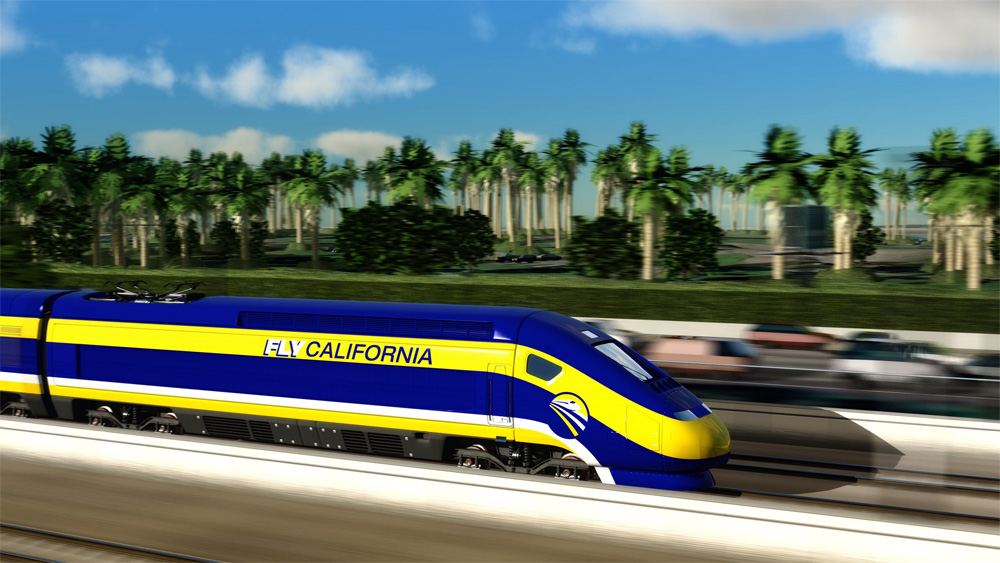
California legislators are now openly mulling raiding high speed rail funds meant to complete the first leg in the Central Valley for rail improvements in the urban parts of California, namely the San Francisco Bay Area and Los Angeles to Anaheim, as the Los Angeles Times reported.
I discussed the idea and its legal soundness on KPCC’s AirTalk radio program yesterday, along with Times reporter Ralph Vartabedian and Glendale City Councilmember and Metro and Metrolink board member Ara Najarian.
Bottom line: this could be the end of the dream of true high speed rail service in the state, but the reality is that the system isn’t going to be high speed anytime soon, absent significant new funding. And using the current funds to provide meaningful transit benefits in California’s major population centers wouldn’t foreclose the idea of upgrading the systems to high speed service at a later date. But once again, it will require significant new funding and the political will to raise it, both of which are big question marks at this point.
As other developed countries race ahead to build high speed rail networks, the U.S. is lagging painfully behind. The result here is now sprawling cities, crushing traffic, significant air pollution, and increased transportation expenses for Americans. But why are the outcomes so different in the U.S. than in the rest of the world?
CNBC produced an in-depth report (video above) to examine some of the reasons, based on interviews with me and UC Berkeley colleague and transportation scholar Robert Cervero, among others. The piece contains some classic 1950s corporate advertisements extolling the virtues of freeways and buses and some good coverage of the various lobbies keeping our infrastructure auto-dependent.
My only quibble is that the piece repeats the false notion that city rail networks in the U.S. were systematically dismantled as a conspiracy by auto interests. The actual picture, as I detail in my book Railtown on the history of the Los Angeles Metro Rail, is much more complicated than that: it points to voter disillusionment with rail networks, coupled with rapid consumer adoption of (and preference for) private automobiles back in those early days, as the main culprit.
Still, the report does a good job presenting the difficulties funding and building high speed rail in the U.S., and it ably describes what would need to happen if the U.S. were to commit to joining the rest of the developed world by building a first-class high speed rail network.
The controversy over the Trump Administration’s effort to claw back billions from the California High Speed Rail project riled up the media, including Fox News, which featured a brief comment from yours truly:
I also spoke with KPCC radio’s AirTalk program yesterday about the fiasco, along with Los Angeles Times reporter Ralph Vartabedian and USC engineering professor James Moore. While both guests have been consistent critics of the project, even they sounded surprised by the Trump move and doubtful that it would hold up.
Finally, StreetsBlog USA weighed in, noting that highway projects don’t get this level of funding scrutiny and that media reports have been slanted against the project in this spate of recent coverage. I offered some comments to them about the unprecedented nature of this attempted funding rollback.
Now we’ll have to stay tuned to see how California responds to this federal move, including potential litigation.
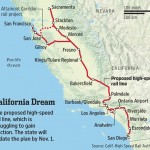
Following Governor Newsom’s downbeat assessment of high speed rail in his State of the State address, the Trump Administration is moving to revoke its existing $3.5 billion commitment to the project, which dates back to the Obama stimulus of 2009. The trouble is that most of the dollars ($2.5 billion worth) have already been spent. Furthermore, as the state’s 2018 auditor report noted, California is not technically in violation of the agreement (yet), which required the state to finish building its Central Valley segment by December 2022.
So the Trump administration will have a hard time clawing those dollars back, though its effort to do so will probably involve a time-consuming, politically bruising process. And that’s a fight that the High Speed Rail Authority doesn’t need to wage right now. Authority leaders can thank the new governor for putting the system back in conservatives’ crosshairs with his State of the State remarks.
Meanwhile, the Governor’s comments and revised approach to the project sparked a lot of recent media interest in the project:
- I spoke to Take Two on KPCC radio (8:30 minutes in) about what the Governor’s revised plan means for the system going forward.
- Matt Yglesias on Vox decried the politicization of the rail route selection and cited my 2014 blog post here on the compromises that were made in forging the system, which cost the system in terms of ridership and construction timelines.
- Alissa Walker at Curbed spoke to me and others about the options now on the table to get the system completed.
None of what’s happening right now seems to be good for getting the project finished. Ultimately, that will require a change in presidential administrations and congress to give California the federal dollars it needs to build the project as originally envisioned.
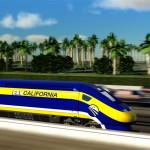
Governor Newsom’s “State of the State” speech today offered an abrupt scaling back of the state’s vision for its signature infrastructure project, high speed rail from Los Angeles to San Francisco:
[L]et’s level about high speed rail. I have nothing but respect for Governor Brown’s and Governor Schwarzenegger’s ambitious vision. I share it. And there’s no doubt that our state’s economy and quality of life depend on improving transportation. But let’s be real. The project, as currently planned, would cost too much and take too long. There’s been too little oversight and not enough transparency. Right now, there simply isn’t a path to get from Sacramento to San Diego, let alone from San Francisco to L.A. I wish there were. However, we do have the capacity to complete a high-speed rail link between Merced and Bakersfield.
In some ways, his position is a simple nod to fiscal reality. There aren’t enough funds right now to complete the project beyond this initial phase in the Central Valley anyway. Voters approved roughly $10 billion in bond funding in 2008, the 2009 federal “stimulus” bill offered another $3.5 billion, and Governor Brown and the legislature dedicated about 25% of cap-and-trade auction proceeds to continue building the system.
But that’s not enough to connect the Central Valley portion through the Pacheco Pass into San Jose, where it could then connect to the soon-to-be-electrified Caltrain into San Francisco. And it’s nowhere near the multiple billions of dollars needed to tunnel through the Tehachapi Mountains to connect to Southern California.
The key is the federal government: with Republicans in complete control of Congress from 2011 until last month, they were unwilling to match the state’s investment with federal dollars. While highway projects will get 90-100% funding from the federal government and intracity rail transit will get 50%, high speed rail has gotten just about 15% in federal matching funds — and only from that one-time 2009 stimulus grant.
If California had received closer to a 50% match from the federal government, the rail system would have the money to connect to the Bay Area. That link would provide significant economic benefits for Central Valley cities like Fresno and Merced by connecting them to the prosperous coastal economy. And it would create immediate benefits to bolster the long-term political support needed to eventually extend the system to Southern California.
But Governor Newsom’s speech today shows that he’s unlikely to spend much political capital to fight for these federal dollars from a congress that now features many California representatives, including the speaker, in control of the House of Representatives. It’s a position consistent with his 2014 interview in which he stated he would redirect funds from the system to other infrastructure needs.
Instead, his scaled-back vision presents a message that may confirm critics’ charges that the system is flawed and potentially infeasible. Some also worry that the new plan will embolden more litigants, arguing that the change in project vision violates the terms of that original 2008 bond initiative, although the courts have so far been deferential to state leaders on this question.
High speed rail backers will ultimately need a change in federal leadership come 2021 to get the necessary funds to complete the project — but it looks like they will have only tepid support from the state’s new governor in the meantime.
High speed rail has been in the news lately for all the wrong reasons, with a scathing state audit indicating that hundreds of millions of dollars — if not billions — may ultimately be wasted by starting construction too early to meet political deadlines, as well as other mismanagement.
I debated the future of the system last week on KPCC radio in Los Angeles, on the program Airtalk with Larry Mantle. Sparring with me was James Moore, civil engineering professor at the University of Southern California (and longtime anti-rail academic).
You can listen to the first part of the show on the Airtalk website, but the full audio (including my last rebuttal to Prof. Moore) is available here.
The short story? Some of the mismanagement is due to the complicated politics of building such a controversial system through the heart of Tea Party California opposition, while the system in general will still be needed to serve a growing population and connect the Central Valley cities to the prosperous coastal economies.
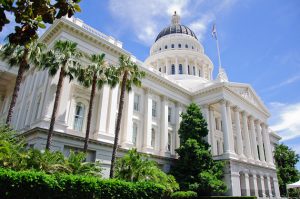 Some big wins for California (and therefore national) climate policy last night:
Some big wins for California (and therefore national) climate policy last night:
- Lt. Governor Gavin Newsom is elected governor, which means the state will continue its climate leadership on various policy fronts
- Prop. 6 loses, which would have repealed the gas tax increase and meant less funding for transit going forward
- Prop. 1 wins, which could provide more money for affordable housing in infill areas, reducing driving miles as a result
- The Democrats win the U.S. House of Representatives, which has a host of implications:
- Oversight of the U.S. Departments of Energy, Interior, and Transportation, plus E.P.A., which have all issued various regulations that hurt climate goals in the state
- Potentially more funding in future budget bills for crucial transit infrastructure, including high speed rail
- Potentially more funding and fiscal support for clean tech, like renewables, energy storage and electric vehicles, depending on how budget negotiations proceed
- Oregon Governor Kate Brown wins re-election, which means that state is well-positioned to adopt cap-and-trade next year, making it the first U.S. state to link to California’s program and potentially creating a multi-state building block for an eventual national carbon trading program
And on the housing front, Governor-elect Newsom has set ambitious goals for building more homes in the state, which if done in infill areas could bring crucial climate and air pollution benefits from reduced driving per capita. Pro-housing “YIMBY” candidates also bolstered their ranks in state government, with the election of former Obama campaign staffer Buffy Wicks to the Berkeley Assembly district.
Setbacks nationally (beyond continued Republican gains in the U.S. Senate) included the defeat of some state ballot initiatives, including a carbon tax in Washington, an anti-fracking measure in Colorado, and a renewable portfolio initiative in Arizona — though Nevada voters did embrace a 50% renewable target by 2030 at their polls.
All in all, a positive night for climate policy in California and beyond.

